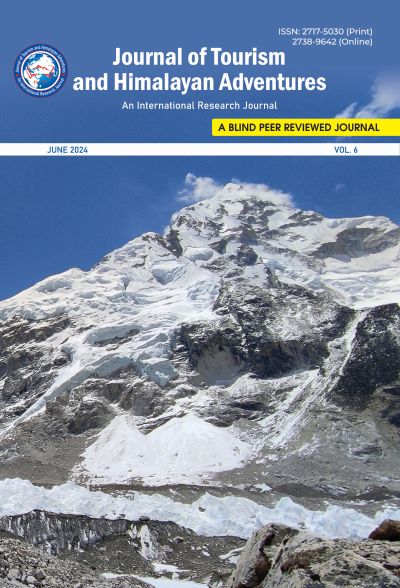Measuring climate vulnerability of tourism-dependent livelihoods: The case of Lamgtang National Park
DOI:
https://doi.org/10.3126/jtha.v6i1.67397Keywords:
adaptive capacity, climate change, livelihood vulnerability, resilience, tourism-dependent communitiesAbstract
Climate change poses significant challenges to tourism-dependent communities in mountain regions, threatening their livelihoods and well-being. However, there is a lack of comprehensive assessments that consider the multidimensional nature of vulnerability and the specific socio-cultural contexts of these communities. This study assesses the livelihood vulnerability of tourism-dependent communities in Lamtang National Park exposed to climate change using the Livelihood Vulnerability Index (LVI) and the Livelihood Vulnerability Index -Intergovernmental Panel on Climate Change (LVI-IPCC) framework. A mixed-methods approach was employed, including household surveys (n=119), vulnerability index calculations, and analysis of weather data. The purposive stratified sampling based on ecological gradient and proximity to trekking trails ensured the representativeness of the sample. One hundred nineteen households were surveyed, with respondents from the Hill Janajati ethnic group. Results showed that the majority of households (63%) were tourism-dominant, followed by agriculture-dominant (17%) and mixed livelihood (13%). The LVI results revealed a moderate vulnerability (0.365), with financial and natural capitals being the most vulnerable. The LVI-IPCC analysis showed that the community's adaptive capacity (0.537) is slightly lower than its exposure (0.564), and sensitivity is comparatively low (0.296), resulting in a low LVI-IPCC index (0.01). Weather data analysis, including the Mann-Kendall trend test, Sen's slope analysis, and multi-model ensemble projections, indicated increasing precipitation trends and a warmer, wetter future for the region. The triangulation of LVI, LVI-IPCC, forecast data, and weather station data strengthens the findings and highlights the need for targeted interventions. The projected changes in temperature and precipitation patterns for Rasuwa district and vulnerability status of tourism-dependent communities highlight the urgency of implementing climate change adaptation measures, which may include diversifying livelihoods, improving access to education and training, strengthening social support systems, and promoting sustainable land and water management practices.




